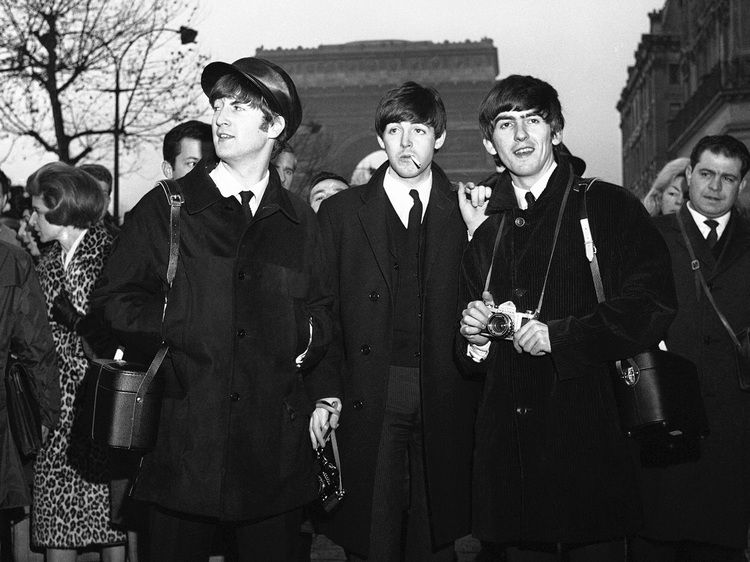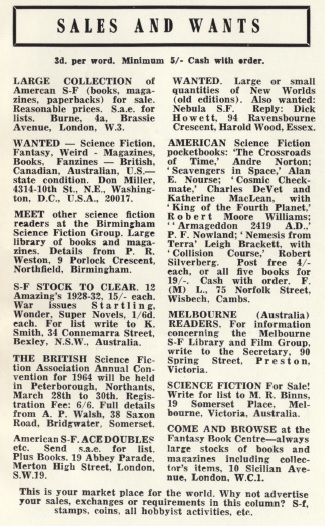[Due to an oversight (clearly!), Galactic Journey was not included on Locus' Awards Ballot this year. If you're a fan of the Journey, we be grateful if you'd fill us in under Fanzine!]

by Gideon Marcus
A New Leaf
Today's special birthday (mine!) edition of the Journey is for the fans. It seems F&SF has been running a three-part series on current (as of 1964) fandom, and it occurred to me it might be fun to spend a little time on the authors who appear in this month's issue. I also want to take the effort to show the context of each writer's work. This is in response to the letter of one of our readers who made me realize I can be a bit harsh (even in jest) on a story. The fact is that writing is hard, and even the worst stories that get printed are usually, though not always, better than most unpublished work.
Which is not to say that anything like Garrett's Queen Bee will ever get a pass, but I'm going to try to be a bit nicer. I will, however, never ask John Boston to change his style; when Amazing is bad, well, you'll know…
The Issue at Hand

This picture, by Mel Hunter, is almost worth 40 cents by itself
Automatic Tiger, by Kit Reed
Kit Reed is one of the writers featured on the Journey whom I am honored to call "friend." She began publishing fiction in 1958, and she is (so far as I know) an F&SF exclusive — and what fortune that is for the magazine! Her work is "soft" SF, where it is SF at all, but since her rough start, Ms. Reed has been a reliably above-average contributor. In particular, her To Lift a Ship, almost a Zenna Henderson The People story, got my nomination for the Galactic Star one year. Sadly, Kit has moved away and left no forwarding address, so our correspondence has come to an end.
Nevertheless, I can still enjoy her fiction. Tiger, the lead tale in this issue, is a vivid piece about Benjamin, a nebbishy fellow who acquires a mechanical tiger, which instantly bonds to his master. Just the knowledge that he is the proud owner of such a creature fills the man with confidence, and he quickly rises in social stature and success. His downfall is an expensive woman and hubris' inevitable companion, nemesis.
It's not SF at all, nor does it make a great deal of sense, but as a fairy tale, it's worthy reading. I have only one significant issue with the story, but it's a central one: I was disappointed that Benjamin ends the story roughly the same as how he started, though now aware of what he's lost. It's a bit like the short story, Flowers for Algernon, except without the inspiring finish. A strong three stars for this flawed jewel.
Sacheverell, by Avram Davidson
More beard than man, Avram Davidson has been a big name in the field since the mid-50s, charming science fictioneers with his sometimes moody, sometimes effervescent short stories. Right around 1962, when he took over the editorship of F&SF, his writing became a bit overwrought and self-indulgent. It's gotten to the point that I generally approach his byline with trepidation (and his editorial blurbs that come before the stories in his mag have gotten bad again, too — thankfully, he's stopped bothering to preface Asimov, at least).
Sacheverell does nothing to improve his reputation. It's about a sapient circus monkey who has been kidnapped, rescued in the end by his carny companions. The story left little impression on me while I read it and none after, such that I had to reread it to remember what it was about.
I suppose forgettable is better than awful? Two stars.
Survival of the Fittest, by Jack Sharkey
I've been particularly harsh on Jack Sharkey. No, not the boxer (who could pound me into hamburger), but the prolific author who has been around since 1959. That's because, while he is capable of quite decent work, much of what he's turned out is pretty bad.
Survival falls somewhere in-between, I guess. It's a variation on the, "is my real life really the dream?" shtick mixed with a healthy dose of solipsism. Not great, but I did remember the piece, at least. On the low end of three stars.
The Prodigals, by Jean Bridge
The first poem of the issue is by newcomer Jean Bridge, and it suggests that after humanity has matured out of a need for interstellar wanderlust, Earth will be waiting, no matter how long it takes.
Unless the sun eats our planet first, of course, though we may be advanced enough by then to save our home out of nostalgia. Nice sentiment, nicely framed. Four stars.
Forget It!, by Isaac Asimov
The Good Doctor probably needs no introduction, having been a titan of sf since his debut in 1938, and a deity of science fact from the 1950s. However, I will note with pride that he is, like me, a Jewish Atheist of Russian extraction, and of very similar age (we're both the same vintage of 39), spectacle frame, height, and writing style.
This particular non-fiction piece, on the superfluous weights and measures we'd be better off chucking, kept me company while I watched my daughter compete (victoriously) at an inter-school academic competition. It's an interesting article, noting that just as the English language has regularized itself almost to the point of sense, but with lingering spelling issues that confound any new learner, so have pecks and bushels and furlongs and fortnights overstayed their welcome. It's time that they went the way of florins and chaldrons and ells. Let's all adopt the metric system like sensible people!
Who can argue with that? Four stars.
Lord Arthur Savile's Crime, by Oscar Wilde
Oscar Wilde is, of course, a fixture of the Victorian age whose wit still finds currency today. This piece, which I read on a long walk one fine morning, is a pleasant tale about Lord Arthur, a young aristocrat with love, money, and not a care in the world — until a cheiromancer informs him he will commit a murder in the near future. Convinced of his fate, the young Lord undertakes to perform the deed in as personally nondisruptive manner as possible.
It reads well, but the ending is just a bit too pat and inconsequential. And while I am appreciative of the opportunity to rediscover lost classics, I am not certain why Davidson chose to devote half an issue to one. I should think that a modern magazine could do with less 1887 and more 1987.
Three stars.
Pure Water from Salt, by Theodore L. Thomas
Theodore Thomas oscillates between mildly engaging and somewhat dreary. A lawyer by profession, he is best with fiction that explores interesting aspects of patent law. This particular piece is about the value of adapting people to process salt water as opposed to pursuing desalination. It feels like an incomplete story outline that Davidson bought to fill a vignette-sized hole.
Two stars — one for each page.
Incident in the IND, by Harry Harrison
After his debut novel-sized effort, the superlative Deathworld, Harrison seemed to be in a bit of a rut with none of his stuff cracking the three-star mark. But Incident, about the evil that lurks in the shadows of the subway tunnels, is a nice piece, indeed. It's got a sharp, atmospheric style that is a big shift from the author's usual Laumer-esque breeziness. If I have any complaint, it's just that I wish it had been the fellow and not the lady who gets et in the end.
Four stars.
Humanoid Sacrifice, by J. T. McIntosh
Scotsman James Murdoch MacGregor, who goes by J. T. McIntosh, has been around since 1951. He hit it out of the park early on with one of my favorites, Hallucination Orbit, and his One in Three Hundred series of stories was good, too. He's another author who has been in kind of a slump lately, but I always hold out hope for his work, given his prior glories.
Humanoid Sacrifice is an engaging-enough tale with two parallel plot threads involving the same protagonist. A human troubleshooter is employed by an advanced alien race to fix their rebelling weather control machine. At the same time, the aliens inform the repairman that they have a human female in suspended animation, a specimen snatched from Earth for study back in 1850. She is thawed and a written correspondence between the two humans ensues.
It's cute and readable and that's about all I can say. Three stars.
The Shortest Science Fiction Love Story Ever Written, by Jeffrey Renner
I don't know Jeff Renner, but I think the magazine would have been better served filling these two inches with one of those little EMSH drawings they used to have. One star.
The Conventional Approach, by Robert Bloch
Bob Bloch has been a pro author for a couple of decades now, creating enduring classics of horror and science fiction. Like Wilson Tucker, he's also kept one foot firmly in the fan world that spawned him. He took over Imagination's "Fandora's Box" column from Mari Wolf in '56 (I still miss her) for instance. Now he has an excellent article on the history of Worldcon, which was so good and witty that I had to read it aloud to my wife on a walk this morning.
I suspect it will be as relevant amd rewarding 55 years from now as it is today. Five stars.
The Lost Leonardo, by J. G. Ballard
Last up is a novelette by a UK author who has made a big splash on both sides of the Pond. His Drowned World garnered a Galactic Star from us, and many of his stories have gotten four or more stars. There's a somber, almost ethereal quality to his work that works or doesn't depending on your mood, I suppose. I liked this one, in which a certain wanderer of Biblical fame becomes an art thief to do penance for his sins.
It's pretty neat, straightforward but well-executed. Four stars.
Summing Up
Goodness, it feels good to be positive for a change! It doesn't hurt that this has been one of the better issues of F&SF, a magazine that has been largely in the doldrums since Davidson took over. Do tell me what you think of these stories and of the fine folk who wrote them!













![[February 23, 1964] Songs of Innocence and of Experience (March 1964 <i>Fantastic</i>)](https://galacticjourney.org/wp-content/uploads/2019/02/640223cover-672x372.jpg)

![[February 21, 1964] For the fans (March 1964 <i>Fantasy and Science Fiction</i>)](https://galacticjourney.org/wp-content/uploads/2019/02/640219cover-665x372.jpg)



![[February 19th, 1964] The Edge Of Disappointment (<i>Doctor Who</i>: The Edge Of Destruction)](https://galacticjourney.org/wp-content/uploads/2019/02/640219stabbystabby-672x372.jpg)

![[February 17, 1964] Breaking Taboos (April 1964 <i>Worlds of Tomorrow</i>)](https://galacticjourney.org/wp-content/uploads/2019/02/6312017cover-672x372.jpg)






![[February 13, 1964] Deafening (the March 1964 <i>Amazing</i>)](https://galacticjourney.org/wp-content/uploads/2019/02/640213cover-672x372.jpg)








![[February 11, 1964] To Gain Ascendancy (<i>The Outer Limits</i>, Season One, Episodes 17-20)](https://galacticjourney.org/wp-content/uploads/2019/02/640211e-672x372.jpg)








![[February 9, 1964] Bargain Basement (March 1964 <i>IF</i>)](https://galacticjourney.org/wp-content/uploads/2019/02/640209cover-672x372.jpg)






![[February 3rd, 1964] And Into The Fire (<i>Doctor Who</i>: The Daleks | Episodes 5-7)](https://galacticjourney.org/wp-content/uploads/2019/01/640203smartypants-672x372.jpg)

![[February 1, 1964] The Vast Wasteland (February 1964 <i>Analog</i>)](https://galacticjourney.org/wp-content/uploads/2019/01/640201cover-672x372.jpg)






![[January 28, 1964] Beatles, Prisons and Doctors ( <i>New Worlds</i>, February 1964)](https://galacticjourney.org/wp-content/uploads/2019/01/640128cover-652x372.jpg)







